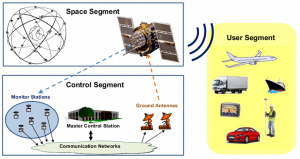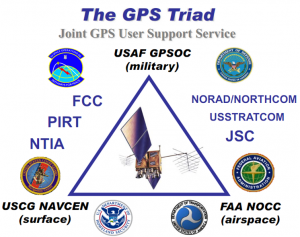If you wish to contribute or participate in the discussions about articles you are invited to contact the Editor
GPS Architecture
| GPS | |
|---|---|
| Title | GPS Architecture |
| Edited by | GMV |
| Level | Basic |
| Year of Publication | 2011 |
The GPS architecture is divided into three major segments: a GPS Space Segment (SS), a GPS Ground Segment (CS), and a GPS User Segment (US).
The Space Segment
The main functions of the GPS Space Segment are to transmit radio-navigation signals with a specific signal structure, and to store and retransmit the navigation message sent by the Control Segment. These transmissions are controlled by highly stable atomic clocks on board the satellites.
The United States is committed to maintaining the availability of at least 24 operational GPS satellites, 95% of the time. To ensure this commitment, the Air Force has been flying 31 operational GPS satellites for the past few years.[1]
The Ground Segment
The GPS Ground Segment (also referred to as Control Segment) is the responsible for the proper operation of the GPS system.
The Ground Segment is comprised of four major subsystems: [2]
- Master Control Station (MCS)
- Alternate Master Control Station
- Network of ground antennas (GAs),
- Network of globally-distributed monitor stations (MSs).
The Master Control Station (MCS) processes the measurements received by the Monitor Stations (MS) to estimate satellite orbits (ephemerides) and clock errors, among other parameters, and to generate the navigation message. These corrections and the navigation message are uploaded to the satellites through the Ground Antennas, which are co-located in four of the Monitor stations (Ascension Island, Cape Canaveral, Diego Garcia, and Kwajalein).
The User Segment
The GPS User Segment is composed by GPS Receivers. Their main function is to receive GPS signals, determine pseudoranges (and other observables), and solve the navigation equations in order to obtain their coordinates and provide a very accurate time. Please refer to GNSS Receivers.
Boundaries Among Segments
The communication boundaries between these three segments are documented in the Interface Control Documents (ICDs):[3]
- IS-GPS-200:[4] defines the requirements related to the interface between the GPS space and user segments of the GPS for radio frequency (RF) link 1 (L1) and link 2 (L2).
- IS-GPS-705):[5] defines the requirements related to the interface between the GPS space and user segments of the GPS for radio frequency (RF) link 5 (L5).
- IS-GPS-800:[6] Defines the characteristics of the L1 Civil (L1C) signal transmitted from GPS satellites to navigation receivers on radio frequency link 1 (L1).
- IS-GPS-240::[7] Defines the functional data transfer interface between the GPS Control Segment (CS) and the GPS user and user-support communities during the Operational Control System (OCS) / Architecture Evolution Plan (AEP) system era.
- ICD-GPS-870:[8] This ICD defines the functional data transfer interface between the GPS Next Operational Control System (OCX) and the GPS user and user-support communities; captures the same interface as ICD-GPS-240, but for the OCX era.
Civil GPS Service Interface Committee
The Civil GPS Service Interface Committee (CGSIC) is the recognized worldwide forum for effective interaction between all civil GPS users and the U.S. GPS authorities. The U.S. Coast Guard Navigation Center (NAVCEN) coordinates and manages CGSIC in cooperation with the Department of Transportation. The Department of Transportation established CGSIC to exchange information about GPS with the civil user community, respond to the needs of civil GPS users, and integrate GPS into civil sector applications. Information from CGSIC members and meetings is provided to United States GPS authorities for consideration in GPS policy development and GPS service operation.[9]
Objectives
- Provide a forum to exchange technical information and collect information on the civil GPS user community's GPS needs.
- Identify information requirements and methods to distribute this information to the civil GPS user community.
- Conduct GPS information studies on civil user needs as requested by DOT or identified by the Committee.
- Identify any GPS issues that may need resolution and submit them to appropriate authorities for consideration.
Committee Composition
The CGSIC is comprised of representatives from relevant private, government, and industry user groups, both U.S. and international. The Committee structure consists of a chair, two deputy chairs, an Executive Secretariat, and an Executive Panel. The Committee is chaired by the Director, Radionavigation and Positioning in OST/P. The first Deputy Chair is Commanding Officer, the U.S. Coast Guard Navigation Center (NAVCEN). The Commanding Officer of NAVCEN is supported by an Executive Secretariat and manages the Committee, maintains membership roles, coordinates Committee meetings, represents the Committee Chair at GPS related meetings, and coordinates responses to submitted issues. The second Deputy Chair is the Deputy Chair for International Affairs and is a non-U.S. representative appointed by the Chair with the approval of the Executive Panel. The Executive Panel consists of the Chair, Deputy Chairs, Subcommittee chairs, a representative from the GIAC, and representatives from three modal areas:[10]
- Aviation - a representative designated by the Federal Aviation Administration to address aviation issues.
- Land - a representative designated by the Federal Highway Administration to focus on land, reference station, and timing issues.
- Marine - a representative designated by the U.S. Coast Guard to address maritime issues.
Subcommittees
The CGSIC may create standing subcommittees, ad hoc subcommittees, or special working groups to work specific areas of civil GPS user needs and facilitate technical information exchange. Standing subcommittees have been established for the:[10]
- International Information.
- Timing.
- U.S. States and Local Government
- Survey, Mapping, and Geo-Sciences
Besides the interface documents, the following three centers (privately referred as the Big Three or the GPS triad) provide a interface between GPS and any user, civilian or military:[11]
- U.S. Strategic Command GPS Operations Center (GPSOC): is the Department of Defense (DoD) primary point of contact for information regarding status of GPS Precise Positioning Service (PPS) and GPS Standard Positioning Service (SPS). The GPSOC is in charge of responding to inquiries and providing information regarding the GPS constellation and the existence of space segment anomalies or issues that could result in GPS outages worldwide.
- U.S. Coast Guard (USCG) Navigation Center (NAVCEN): is the primary interface to all civil non-aviation users of GPS. It provides capabilities for question or issue resolution regarding GPS anomalies and interference reporting, to support maritime and land users with prioritized approach for safety-of-life applications.
- Federal Aviation Administration (FAA) National Operations Control Center (NOCC): Responsible for the management and resolution of all aviation reported interference. Due to the safety-of-life considerations, the FAA has well-defined procedures for dealing with the notification and coordination of any interference reports from aviation users, which includes the processing of National Airspace System (NAS) interference reports and specifically, GPS interference reports.
Notes
References
- ^ GPS Space Segment information in GPS official website
- ^ GPS Ground Segment in GPS official website
- ^ GPS Interface Control Documents ICDs
- ^ Interface Specification IS-GPS-200, Revision L
- ^ Interface Specification IS-GPS-705, Revision G
- ^ Interface Specification IS-GPS-800, Revision G
- ^ Interface Specification IS-GPS-240, Revision C
- ^ Interface Specification ICD-GPS-870, Revision E
- ^ Civil GPS Service Interface Committee in GPS official website
- ^ a b Civil Global Positioning System Service Interface Committee Charter in GPS official website
- ^ U. S. Positioning, Navigation, and Timing Interference Detection and Mitigation Plan Summary


